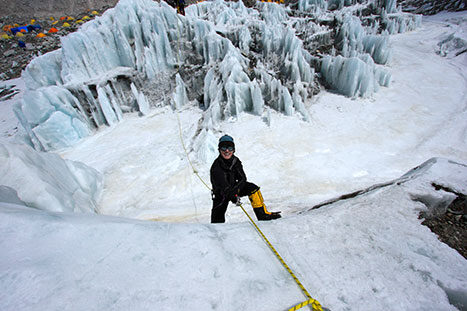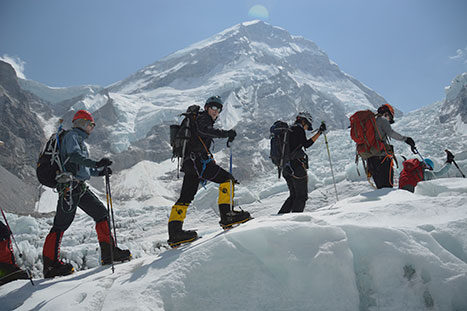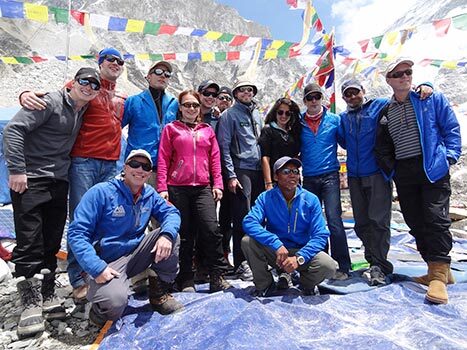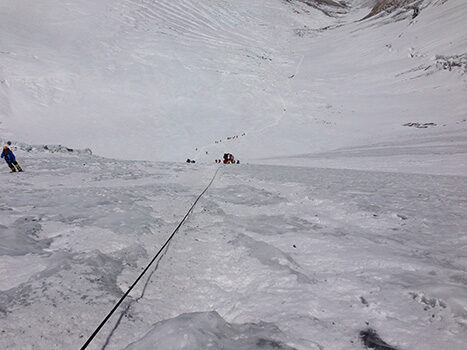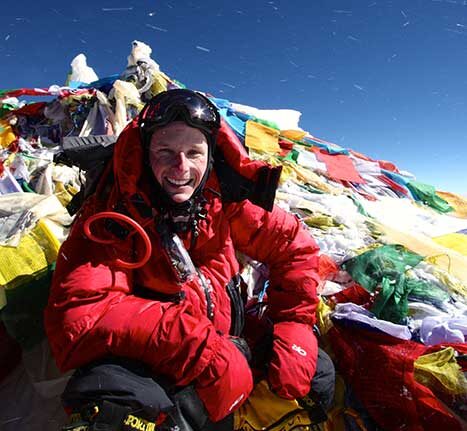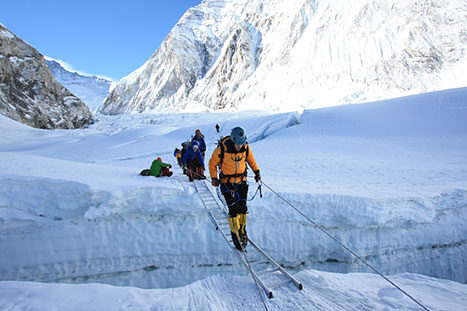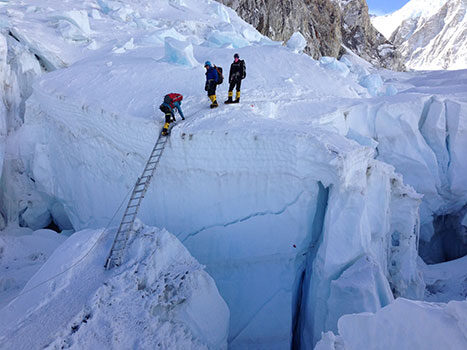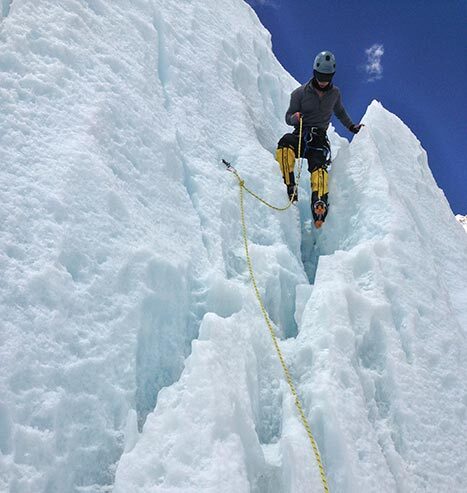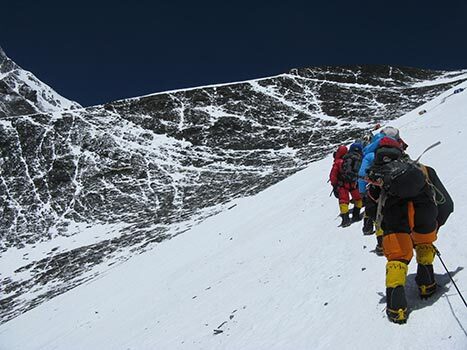Climb every mountain
What can a trek up the world’s tallest peaks reveal about leading an organization? Just ask leadership expert and mountaineer Scott DeRue, management professor at the Ross School of Business. DeRue began climbing in 2007 and has summited Mount Kilimanjaro and Mount Everest, among others. In September he will direct the Ross School’s executive education course Advanced Leadership in Action: Kilimanjaro. The seven-day trek will take participants from the depths of the African rain forest to the heights of this majestic peak. After summiting Everest in 2013, DeRue linked lessons learned on the mountain to teambuilding and leadership at work. He shares those thoughts in the captions below.
-
Setting “Everest goals”
Mountaineering is a great metaphor for setting and accomplishing big goals. It’s physically and mentally challenging, some mountains more than others. Life is a series of mountains. I often ask people: “What is your Everest goal?” We all have big dreams, but few of us are bold enough to go after them. (Here, DeRue practices traversing the ice falls near base camp at 17,500 feet. Image by Ben Jones.)
-
The team, the team, the team
You don’t climb mountains alone. You come together, usually with people you don’t know, and must develop into a high-performing team that is resilient and focused on results. That’s what I study and teach every day at the Ross School. I am fascinated by group dynamics: Why is this team great, and this team not? In mountaineering you get to live that. It’s a microcosm of everything we talk about in business. (Here, the team moves through the Khumbu Ice Fall, approaching 19,600 feet. Image by Martin Grieder.)
-
Finding inspiration
On Everest, you are surrounded by inspirational people. There’s an 80-year-old Japanese man climbing. There’s a guy running from the bottom to the top trying to set a speed record. Everybody wants to be the “first something” on Everest. Everywhere you look, there is inspiration to be found. For me personally, it wasn’t about being first. It was about being part of something special, something bigger than one person. (The team at base camp, 17,600 feet. Image by Scott DeRue.)
-
Keeping priorities in perspective
One thing I really appreciated about our team on Everest was that we had mutual respect. That was critical when one of our members had an equipment failure. We had to use every bit of trust and training we had developed to organize and help him. That is success. It was a perfect illustration of what a great team, through the course of time, had become. When the stakes were highest – when lives were on the line – we focused not on ourselves but on the team. The team must come first. (This is a view looking down at the Lhotse face, from about 23,600 feet. Image by J.P. Bailey.)
-
It’s the journey, not the destination…
Everyone wants the summit picture, right? I too am very proud of the summit. But my memories are not of the summit. They are of the journey along the way. You spend months, even years, training. You spend two more months on the mountain itself acclimatizing. Finally you reach the summit. We were on the top for maybe 15 minutes. The summit was special but it was the journey that I will forever remember. (29,035 feet. Image by Ben Jones.)
-
Head in the game
There are places on the mountain where every step matters. You can’t make a mistake. You can sense the anxiety in the air: “We’ve never gone through this before.” There are massive crevasses to cross, which go hundreds of feet down. You cross them on a simple ladder, just laid across the gap. You ask yourself: “How much can I do?” And it’s always more than you think, because you’re prepared, focused, and together with your team. (Image by Ben Jones.)
-
Step by step
Climbing Everest is not only a test of resilience, but also of patience. The same thing is true in life. You have to break big aspirations down into smaller goals. One of the hard things about Everest is that you climb up part of the mountain and then climb all the way back down. You climb up a little more, and then all the way back down. You cannot race to the top or you die. After it is all done, others may only see your big accomplishment, but you will remember the small wins that got you there. (Image by J.P. Bailey.)
-
Commitment is good, until it’s not
People commit time, energy, and money to pursue their dream of climbing Everest. It is not uncommon for people to spend $70,000 on an Everest trip, and some return for multiple attempts. This commitment is good until it is not. You see some odd decisions on the mountain. Because of their investment of time and money, people’s rational thinking can go out the window. When people die up there, it’s often because of decisions clouded by poor judgment and an irrational escalation of commitment. (Image by Martin Grieder.)
-
You are not done — until you are done
The summit is not the end of the journey. You’re only halfway there. As Ed Viesturs, a famous and accomplished mountaineer said, “Getting to the top is optional, getting down is mandatory.” What most people don’t realize is the hardest and most dangerous part is actually getting down. People think, “I summited Everest,” and they inevitably relax. That’s when accidents happen. So the lesson is: You must stay present and in the moment every day, every step. That’s the real challenge. (Image by Adriaan Wessels.)
-
Kilimanjaro course
Action-based learning is our focus at the business school. For something like Everest, we can put students through a simulated experience and now, as their teacher, I can enrich that simulated experience with my own lived experience. In the September course for Exec Ed, we will take this to an entirely new level as we climb together on Kilimanjaro. As the tallest mountain in Africa, Kilimanjaro is a true beginner mountain but still a significant accomplishment that is attainable for the average person. More importantly, it is a wonderful laboratory for learning to lead and build high-performing teams. At Ross, we aspire to develop leaders who make a positive difference in the world, and Kilimanjaro is the next evolution in leadership training.
(Here, DeRue’s team is en route to Camp 4, at 26,100 feet. Image by Adriaan Wessels.)
-
Me vs. we
On the mountain, and in business, you team up with a lot of talented individuals who have their own personal goals. The only way you win is to think about we, not me. If you have these talented climbers thinking about “me” all the time, what happens when someone falls? If you’re a me-focused team the entire six weeks before that person falls, it’s not like you can transform instantly into “we.” It’s the same in any organization: How do you align individual goals with a collective, shared vision while maintaining respect for each person’s own values and aspirations? (Individual tents dot the base camp, at 17,600 feet. Image by Martin Grieder.)
-
Fear factor
Everyone experiences fear. For me, fear was not about, “I don’t think I can do this,” but more about, “If I don’t do this right, the consequences can be life or death.” And that’s part of keeping focused. If you’re not scared up there, then something’s wrong. Part of that may be why you do get to the top. It applies to business too. If you’re naive enough to think “I’ve got this,” then it’s over. On Everest that plays out in real time. If you’re not naive enough to think, “This is easy, no problem,” then you won’t mind the details required to stay safe and be successful.
-
Game changer
Summiting Everest (pictured from about 26,100 feet) doesn’t necessarily change you. But it did remind me of character traits that I aspire to exhibit: Think we before me. Be resilient in the face of obstacles. Do things right, and do the right thing. But mostly, I have a greater appreciation for the journey now as opposed to getting wrapped up in all the distractions and forces trying to throw us off the path toward our goals. Also, a trip like this reminds you of just how much you value relationships — personal and professional — and the opportunity to have a positive impact on the world. Sometimes you have to get away from it all to realize how much you really do appreciate it. (Image by Martin Grieder.)

